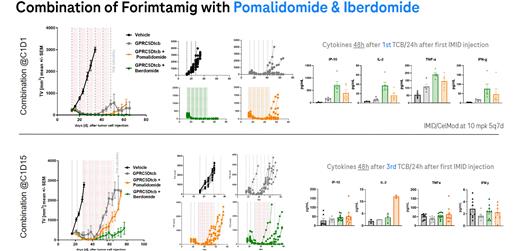Despite novel therapeutic options leading to a substantial increase in survival rates, multiple myeloma (MM) still represents an incurable disease. T cell bispecific antibodies (TCBs) have become a novel therapeutic option for relapsed refractory myeloma (RRMM) patients based on their promising objective response rates (ORR), favorable safety profile and off-the-shelf availability as compared to CAR-T cell therapies. Although BCMA- and GPRC5D-targeted TCBs have been reported to induce deep clinical responses, antigen drift represents a tumor intrinsic resistance mechanism limiting durability of responses 1. Here, we report that the combination of forimtamig, a 2:1 GPRC5D-targeted TCB, with CELMoDs, but not IMIDs, prevents tumor relapse driven by target-negative myeloma cells in a preclinical model of multiple myeloma.
In order to mimic acquired TCB resistance in vivo, stem-cell humanized mice were engrafted with NCI-H929 tumors and treated once weekly (QW) with fixed duration forimtamig at 0.1 mg/kg for 6 cycles with a treatment-free follow up of more than 2 weeks. Single administration of forimtamig reduced tumor load by 80% at the end of cycle 1 (C1). At the end of cycle 4 (C4), all mice achieved a complete response (CR) with no detectable tumors. However, between C4 and cycle 6 (C6), tumor escape was observed in 47% of animals and progression free survival rate (PFS) at study termination was 53%. Relapsed tumors were subjected to quantitative immunohistochemistry and while prevalence for BCMA was comparable to baseline, GPRC5D expression was lost.
To evaluate if cereblon modulation represents a strategy to improve PFS, we combined fixed-duration forimtamig with either pomalidomide (pom) or iberdomide (iber) at C1 day 1 (C1D1). Combination with pom and iber increased anti-tumor response compared to monotherapy during C1 deleting 88% and 92% of tumors, respectively. PFS for the combination with pom was not improved (~50%) as tumor escape was observed after treatment was stopped at C6. In contrast, no tumor relapse was observed for the combination with iber increasing PFS to 100%. Notably, as compared to forimtamig monotherapy, combination with pom and iber further increased serum levels of IFNg, IP-10, IL-2 and TNFa 48h after TCB dosing. We next explored if a sequential start of the combination would impact PFS and cytokine release and started co-administration at C3 instead of C1. Forimtamig induced strong tumor regressions in 90% of animals during C1-C4, but tumor escape was observed in 100% of animals starting after C4. When combined with pom or iber, PFS rates increased to 30% and 60%, respectively. Overall cytokine release was significantly lower compared to C1 and neither addition of pom nor iber led to an increase in cytokine production as compared to forimtamig monotherapy.
To explore the potential of CELMoD combination at significantly lower TCB starting and target doses, we introduced step up dosing for forimtamig reflecting clinically relevant exposures and combined with thrice weekly (Q3W) or five time a week (Q5W) dosing of mezigdomide (mezi) starting at C1D1. Although forimtamig induced transient tumor regressions at C1D1 as well C1D15, mice showed progressive disease at the end of C1 and only 20% of mice achieved a CR at the end of the study. In contrast, combination with mezi led to rapid onset of tumor regression during C1 correlating with significantly improved PFS rates of 80% (Q3W) and 100% (Q5W). Cytokine release was measured after each step up and target dose and a maximal 2-fold increase in combination with mezi was detected. Interestingly, in contrast to IL-2 or IP-10, serum levels of IL-8 as well as MIP-1a decreased for the Q3W mezi schedule.
Taken together, our data suggest that combination with CELMoDs but not IMIDs can prevent relapse to forimtamig driven by GPRC5D negative tumor cells. We confirm timing of intervention with CELMoDs to have an significant impact on PFS and cytokine release and suggest a broad therapeutic window using low dose forimtamig and intermittent dosing of iberdomide or mezigdomide.
References:
1Mailankody S, Devlin SM, Landa J, et al. GPRC5D-Targeted CAR T Cells for Myeloma. N Engl J Med. 2022;387(13):1196-1206. doi:10.1056/NEJMoa2209900
Disclosures
Eckmann:Roche/Genentech: Current Employment. Hage:Roche/Genentech: Current Employment. Stefanie:Roche/Genentech: Current Employment. Bayer:Roche/Genentech: Current Employment. Klein:Roche/Genentech: Current Employment, Current equity holder in publicly-traded company, Other: Stock ownership, Patents & Royalties. Umana:Roche/Genentech: Current Employment, Current equity holder in publicly-traded company, Patents & Royalties.


This feature is available to Subscribers Only
Sign In or Create an Account Close Modal